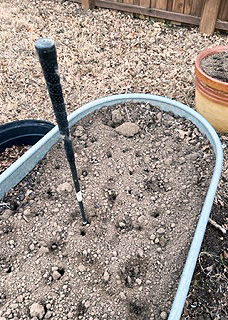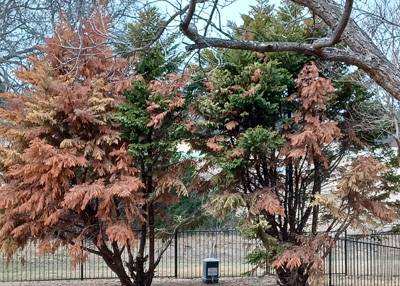Q&A – Ask Neil: February 9, 2023
(Please read these instructions carefully.)
Before you post your question, please look at recent issues to see if someone else has already asked it. You might find your answer there.
How to submit your question…
• Click the link provided below to post your question. After you submit your question, a new window will pop up giving you the address to which you can e-mail a photo to accompany your question. Clear, medium-resolution photos. (Try to avoid low-res thumbnail photos, please, in case I have to zoom in to see things.)
• Click here to post your question.
• Please only post your question one time.
• One question per reader, please.
• Please use this only for posting questions – not for standard emails.
• Watch for your answer in the following week’s e-gardens.
• I choose those of greatest general interest. For example, plant IDs seldom make the cut.
• I must have your first name or initials.
• I must have your city or county. (Texas is a very large state.)
QUESTION 1
CAN DWARF YAUPONS BE CUT BACK TO 6 INCHES FROM THE GROUND?
Question: My dwarf yaupons have gotten too large for their area. Can I cut them to 6 inches from the ground to see if they would come back? If not, I will just remove them and plant something else. Don N., Granbury.
Answer: That’s a really major pruning! They probably will come back, but they may not look uniform as they do. How short do you want them to be ultimately? You should cut them 2-3 inches shorter than that to give them room to regrow. But keep in mind that there probably aren’t any real shrubs that stay any shorter than dwarf yaupons, so consider your options before you do anything rash. Consider replanting with new dwarf yaupons, perhaps 1- or 2-gallon-sized plants. Keep them trimmed short from the outset.
Boxwood can be kept short, but not any shorter than dwarf yaupons, at least not for many years. Dwarf abelias? Nope. Wouldn’t be my choices. Maybe Flirt or Harbour Dwarf nandinas. Dwarf rosemary and germander are pretty herbs that might make a short border, but they aren’t going to last for many years. Rosemary, for example, will likely freeze in Hood County before too many winters. But you didn’t ask for my suggestions, so I’ll go back to minding my own business.
QUESTION 2
WHY DO CHOCTAW PECANS REMAIN IN HULL AND TURN BLACK, NOT MATURING?
Question: The last two years half of my Choctaw pecans have not matured. They have remained in the outer hull. They have turned black on and off the tree. What is happening? Howard G., Haskell.
Answer: When pecans develop black spots on their husks and fall prematurely (late July and August), then are black and watery inside, that’s a disease called pecan scab. You must address it by including a fungicide labeled to control pecan diseases with each application of insecticide you make from late spring until fall. Even better, you should plant a scab-resistant variety at the outset. Honestly, you’re far enough west that scab shouldn’t be a recurring problem. It’s more common in humid areas of East Texas.
It sounds like you might also have a problem with hickory shuckworms. They tunnel within the shucks of the pecans and, in doing so, cut off the supply of water and nutrients getting to the kernels as they are developing. They’re active in late summer at the time that the pecans have formed and as they are filling out. Affected pecans will hang in the trees long beyond normal pecan-drop time of late fall. When they eventually do fall over the winter you will find that they are hollow and ruined inside. Reduce shuckworm populations dramatically by spraying a labeled insecticide the first week of August and repeating the third week of August.
QUESTION 3
GRUB WORMS KILLED OUR ST. AUGUSTINE. WHEN SHOULD WE TREAT FOR THEM, AND WHAT SHOULD WE USE BEFORE WE REPLANT WITH ZOYSIA?
Question: We have been told we lost most of our front yard due to grub worms. We want to replace it with zoysia. When should we treat to prevent the grubs from returning, and what should we use? Kathy H., Euless.
Answer: Please be very careful with the diagnosis before you go to the expense of replanting. I also live in the Metroplex, and I have seen 100 times more St. Augustine lost to chinch bugs in recent years than to grub worms. Even take all root rot and gray leaf spot far exceed grub damage. Please see my information archived on my website simply because I get so many questions about St. Augustine issues.
However, to answer your question, you would apply Imidacloprid granules in late June followed by a deep watering. But do that only once you have confirmed that you had grub worms in your soil. Even though they have finished their feeding for this life cycle, you actually should still be able to dig and find them now. You would need to find 4 or 5 per square foot of soil for there to be enough to do significant damage.
QUESTION 4
HOW CAN I TELL IF THE RECENT ICE HAS KILLED OR DAMAGED MY LANDSCAPE PLANTS?
Question: How can I tell if the recent ice has killed or damaged my new landscaping? Van. R., Farmers Branch.
Answer: Let the plants “tell” you. Ice damage will primarily be from its weight breaking branches. Ice is a good insulator against cold, and temperatures didn’t drop too low last week anyway. There actually was more cold damage done by the Christmas hard freeze than by the ice storm last week. I would suggest just waiting another week or two and then trimming off any dead, brittle growth as needed.
QUESTION 5
DOES IT HELP TO AERATE MY VEGETABLE PLANTERS?
Question: I use an old golf club shaft to aerate my 24-inch-deep vegetable planters. I do this several times before planting. Is this beneficial, or am I wasting my time? Michael C., Tarrant Co.

Answer: It won’t hurt, but value will be limited because it’s impacting only a small amount of the soil at a time. If you have any way of adding fresh organic matter prior to planting that would be really beneficial to your plants.
QUESTION 6
HOW CAN WE REMOVE GRAVEL AND BRING IN FRESH SOIL WITHOUT HARMING OUR OAK TREES?
Question: The previous owners had gravel and cactus in our home’s landscape. We have two mature oaks (post oak and live oak) that shade most of the yard. We would like to remove the gravel and bring in new soil so that we can relandscape the smallish front yard. How can we do that without harming the oaks? Cindy A., Burnett
Answer: Removing the gravel will be no problem. What you don’t want to do is bring in new topsoil to cover the area. It’s fine to add compost, bark mulch, peat moss or other organic matter and rototill carefully to blend it into the top 1-2 inches of the soil. Avoid damaging the major roots as best you can. Post oaks are especially sensitive to additions of soil. Be mindful, too, of roots you might be cutting as you put in new sprinkler lines.
QUESTION 7
WILL BRANCHES OF LEYLAND CYPRESS SPROUT OUT AGAIN IF THEY HAVE SEIRIDIUM CANKER?
Question: I have two Leyland cypress trees that are apparently affected by Seiridium canker. Will the branches sprout again, or should they be cut off the trees? Ruth W., Collin Co.

Answer: Sadly, not only will those branches not sprout out again, but the disease is already in the main trunks of the trees. We do not have a treatment for this disease, either as a preventive or as a cure. You can remove the dead branches, but more will follow right behind them. I’m sorry. It’s a horrible disease. Eastern redcedar juniper would be a very attractive replacement of equal size and growth form. It’s the juniper that is native throughout Collin County. It’s sometimes sold in nurseries, or you could (with permission) dig small transplants from a farm field. They transplant far more successfully in 15- to 18-inch sizes. They must be dug during the winter dormant season. Space them at least 16 feet apart.
